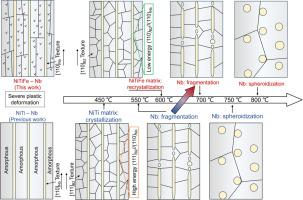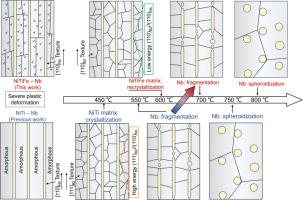通过纹理工程提高镍钛铁基体中铌纳米线的热稳定性
IF 8.3
1区 材料科学
Q1 MATERIALS SCIENCE, MULTIDISCIPLINARY
引用次数: 0
摘要
金属纳米线以其高强度和大弹性应变极限而著称,在复合材料中提供非凡的结构和功能特性方面显示出巨大的潜力。然而,由于碎裂和球化(由过剩的界面能量驱动的过程),它们在高温下的完整性往往受到损害。在这里,我们在 NiTiFe/Nb 纳米复合材料中证明,通过调整纳米线和基体之间的界面晶体取向关系,可以显著抑制 Nb 纳米线的碎裂和球化。通过在镍钛中掺杂铁,我们抑制了镍钛基基体在剧烈变形加工过程中典型的变形诱发的非晶化。常见的(111)NiTi//(110)Nb 纹理被抑制,取而代之的是(110)NiTiFe//(110)Nb 纹理。这种纹理的变化使铌纳米线在镍钛铁基体中的温度高达 700°C 时仍能保持其完整性,而在同类基体中的温度仅为 550°C。模拟结果表明,铌纳米线热稳定性的增强归因于 (110)NiTiFe 和 (110)Nb 之间界面能的降低。此外,铁的掺杂还提高了铌扩散的迁移能垒,进一步阻止了碎裂和球化。本文章由计算机程序翻译,如有差异,请以英文原文为准。


Enhancing thermal stability of Nb nanowires in a NiTiFe matrix via texture engineering
Metallic nanowires, renowned for their high strength and large elastic strain limits, have shown significant potential in rendering extraordinary structural and functional properties in composites. However, their integrity at high temperatures is often compromised due to fragmentation and spheroidization, processes driven by excess interfacial energy. Here, we demonstrate in a NiTiFe/Nb nanocomposite that the fragmentation and spheroidization of Nb nanowires can be significantly suppressed by tailoring the interfacial crystallographic orientation relationship between the nanowires and the matrix. By doping Fe into NiTi, we inhibit the typical deformation-induced amorphization of the NiTi-based matrix during severe deformation processing. The common (111)NiTi//(110)Nb texture is inherently suppressed and (110)NiTiFe//(110)Nb texture is formed instead. Such a change in texture allows Nb nanowires to retain their integrity up to 700 °C in the NiTiFe matrix, in contrast to the 550 °C in the counterparts. Simulation results indicate that the enhanced thermal stability of Nb nanowires is attributed to the reduced interfacial energy between (110)NiTiFe and (110)Nb. Additionally, Fe doping elevates the migration energy barrier for Nb diffusion, imposing further resistance to fragmentation and spheroidization.
求助全文
通过发布文献求助,成功后即可免费获取论文全文。
去求助
来源期刊

Acta Materialia
工程技术-材料科学:综合
CiteScore
16.10
自引率
8.50%
发文量
801
审稿时长
53 days
期刊介绍:
Acta Materialia serves as a platform for publishing full-length, original papers and commissioned overviews that contribute to a profound understanding of the correlation between the processing, structure, and properties of inorganic materials. The journal seeks papers with high impact potential or those that significantly propel the field forward. The scope includes the atomic and molecular arrangements, chemical and electronic structures, and microstructure of materials, focusing on their mechanical or functional behavior across all length scales, including nanostructures.
 求助内容:
求助内容: 应助结果提醒方式:
应助结果提醒方式:


